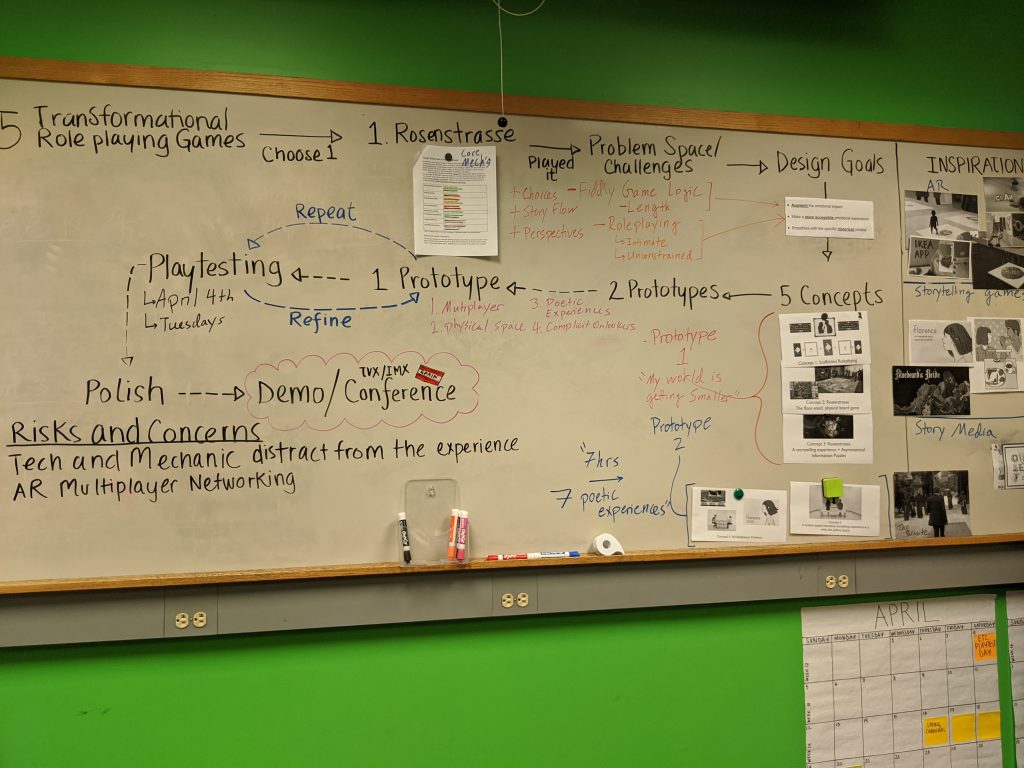The two biggest goals for Week 4 were to
-1) Communicate the design space and progress of the team during Quarter walk arounds
-2) Create initial designs to separate between Prototype 1 or 2 in order to choose which of the two to proceed forward with.
Unfortunately, preparations for the first took up more time than anticipated and resulted in abridged time to create interactive prototypes for either idea. While Art and UI were able to create mood boards, Design was unable to create paper prototypes that captured the core feelings of either pitch. Tech was able to create a Networking Gold Spike and basic AR glyph recognition in lieu of more specific AR functionality or features in service of a larger design goal. In theory this functionality would be core to either pitch, but we lacked specificity for what we wanted each design to do.

Quarters presentations were fairly successful with faculty providing feedback that demonstrated an understanding of the goals of the project: we were definitely able to tell them what we wanted to do, but many faculty are skeptical of our ability to do it.
In terms of materials we created a roadmap documenting our process and our current Design goals of:
-Augmenting the current storytelling experience (e.g. concentrating the emotional impact, using media other than text)
-Making the experience more accessible (e.g. by lowering the barrier to entry to verbal roleplaying)
-Conveying Historical information besides through text (e.g. creating a floor sized board representing Berlin)
Feedback from the faculty fell broadly into 4 categories:
- We need to figure out the specific space affordances of IMX. Are players going to be exposed to crowds? Can we get a blackbox curtained off space? Can we get mood lighting? Should we just showcase promotional materials instead of the experience itself.
- We need to be very specific with how we use AR. AR has a very bad track record for immersive storytelling. Managing attention is very tricky. Making people hold iPads will fatigue them. The real world will never be as good or as entertaining as the fictional world, so much so that seeing a real wall will likely break immersion, a crucial component of Role-playing games. Players of AR games also don’t tend to play with AR mechanics for more than 10 mins at a time.
- One very insightful conversation revolved around the logistics of having iPads rendering AR: the iPad batteries will die VERY fast. Additionally whose iPads will they be? The ETCs?
- We need to seriously consider our design goals in relation to Rosenstrasse: The current design goals are not specific to the Transformational goals or the storytelling goals of Rosenstrasse. Rather they appear to be specific to accessibility of roleplaying games.
- We need to start prototyping and thinking about how to build a floor sized board. The idea of the board got a lot of faculty’s attention but raised questions about materials, its role in the broader design of the game, interaction with AR mechanics, etc.
Quarters were followed with a further sit down meeting with Chris Klug and Drew Davidson who echoed many of these statements. Drew in particular noted two options for our team to “create poetic experiences using AR.” We could focus on the tech managing the complex logic and just enable verbal roleplaying OR we could attempt to foster those feelings from mechanics besides roleplaying (such as by looking at images together).
Our meeting with our client cemented our team’s direction: pursue the second prototype with the physical board from the first prototype. With this in mind, the project has 4 design pillars:
- Multiplayer: the experience will have at least 2 people interact with both the game and any other player in the experience.
- Sacred Physical Space: the experience will have a physical space where players traverse a physical board that adds to the emotional experience
- Poetic Experiences: the game will revolve around interactive poetic experiences that capture the emotional essence of the source material. In other words, players should experience similar emotions as the original Rosenstrasse but with mechanics or actions specific to AR.
- Complicit Onlookers: the experience will have mechanics for onlookers that captures the essence of being complicit in the suffering of Jews under the Nazi regime. This might take the form of a reporting mechanic that impacts the experience of those in the sacred physical space.
Our team elected to move our usual sprint planning session from Friday afternoon to core hours of Monday afternoon with the intention to come with ideas that answer these 4 design pillars.
Overall a busy week. In a perfect world we would be situated to very soon exit pre-production (or even pre-pre-production a term coined by Dave Culyba to refer to Client teams that must figure out the bounds of their creative space before figuring out how to tackle it design-wise). Next week we hope to have a playable experience with an answer to these design pillars in mind. What weighs heavy on my mind is the reality that the halfway mark is only 3 weeks away. If all we’ve accomplished in 4 weeks is slightly more certainty and no builds, I worry that in 7 weeks we will have accomplished 2 builds and knowledge of how we failed to meet our design goals. Time will tell and builds are the path forward.
